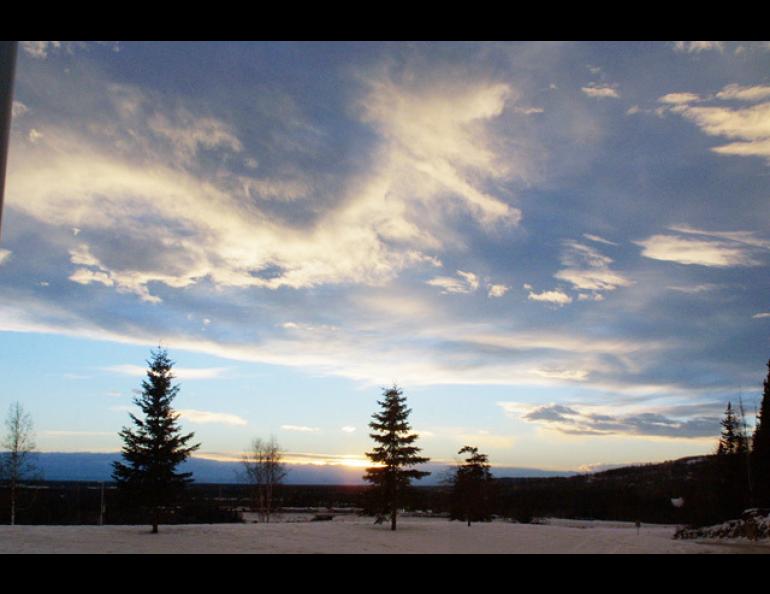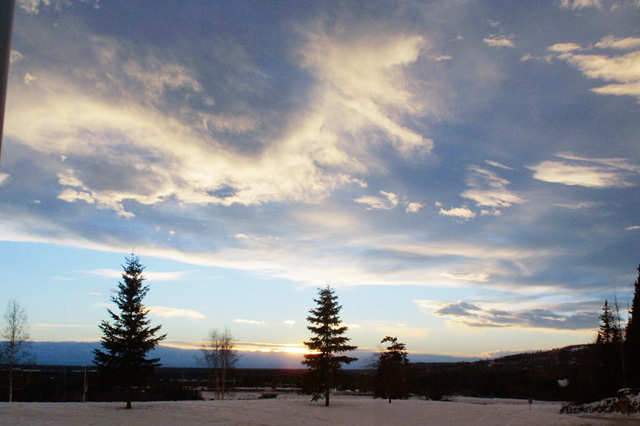
Alaska Weather Patterns Skewed by Terrain
April 2002 was the wettest April ever recorded in Fairbanks, with sticky blankets of snow invading what has been the driest month since people began keeping official records here in 1904. As springtime Fairbanks does its impression of August, it makes a person wonder: are there any fail-safe weather patterns in Alaska?
Interior Alaska has a few familiar but imperfect trends, according to meteorologist Jim Brader and hydrologist Eric Stevens, both of the National Weather Service office in Fairbanks:
Southwest flow and wet Augusts: In spring 2002, the jet stream, a high-speed ribbon of air that belts the globe and carries weather systems, tilted northward. The shift set the Interior up for "southwest flow," during which moist air follows a natural duct between the Alaska Range and Kuskokwim Mountains, falling out as rain or snow when it reaches the Tanana Hills surrounding Fairbanks. Southwest flow often makes August the wettest month of the year in Fairbanks.
Afternoon thunderstorms in early summer: People living in the Interior can almost set their watches by thunderstorms in late May and June. On clear days, the sun warms the ground in the mornings, liberating moisture into the air. About 11 a.m., puffy cumulous clouds form over the hilltops. By 3 p.m., the clouds have morphed into towering cumulonimbus, and a thunderstorm often follows.
High pressure and cold snaps: Bouts of extreme cold weather in the Interior are often the result of a high-pressure system sitting over northern Alaska at the same time a low-pressure system is present over the Gulf of Alaska near Yakutat. The Yakutat Low has the effect of sucking cold arctic air over the Interior.
Chinook winds: Several times each winter, strong winds top the Alaska Range from the south and raise temperatures in the Interior. Dry chinook winds can raise temperatures to as high as 50 degrees above zero in the dead of winter.
Temperature inversions: Inversions, in which warmer air forms a lid that traps cold air near the ground, occur in the Interior from September to May. The ingredients needed for a temperature inversion are low solar radiation, clear skies that allow heat to escape, and calm air. An inversion also needs a natural bowl to hold an air mass; in Fairbanks that container is the Tanana Hills.
Topography, such as the Tanana Hills north of Fairbanks and the Chugach Mountains to the east of Anchorage, is one of the most important features in Alaska weather.
"Patterns can change with the time of year, but terrain is the biggest weather-maker in Alaska," Brader said.
The mountains on the Southeast panhandle are a good example of how Alaska's mountains and valleys affect weather. The Aleutian Low, one of the major areas of atmospheric activity in the Northern Hemisphere, often teams with the jet stream over the Gulf of Alaska to drive winds into Alaska's panhandle, slamming the mountains with lots of rain and snow and making it perhaps the wettest place in the world. Just over the mountains to the east, the Yukon Territory is almost a desert.
"Here and across Alaska, terrain gives us a lot of exceptions to our patterns," said Joel Curtis, science and operations officer for the National Weather Service in Anchorage. "In the Great Plains, if you have strong low-level south winds, you'd call for extreme weather almost 100 percent of the time, but that's not the case in Alaska."
"We've got an ocean-land environment and lots of terrain, along with a large data void where weather originates to the southwest," Curtis said, referring to the North Pacific Ocean, where no weather stations exist. "That makes forecasting extremely difficult."





